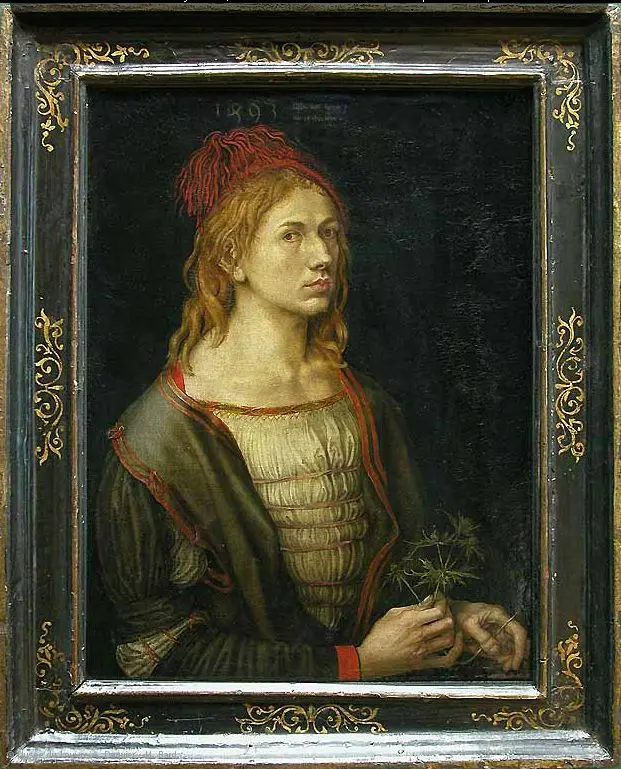Avtoportret s Holly (avtoportret z oslico)
Description of the artwork «Avtoportret s Holly (avtoportret z oslico)»
This is the first of Dürer's oil paintings. In total, three of them are known: the first is the Louvre, second kept in Prado (Madrid), and the third and the most famous one in Munich's Alte Pinakothek.
While Dürer traveled in the vicinity of the Upper Rhine and improved, getting acquainted with famous artists in Germany and sketching views of cities and mountains, his father in Nuremberg married him a bride. He informs his unsuspecting son, who was at that moment in Strasbourg, about the matchmaking as a fait accompli. Father did not write almost anything to Dürer about the girl Agnes Fry, but he told a lot about her parents: the future father-in-law Hans Fry, a master of interior fountains, is about to be appointed to the Grand Council of Nuremberg, and the mother-in-law is generally from the patrician (albeit impoverished) Rummel dynasty ...
The elder Dürer, himself a Hungarian grain grower, really wanted to make a good party for Albrecht and therefore demanded that his son finish all his unfinished business and return to Nuremberg, and in the meantime, is he now or who is an artist? - to write and send her own portrait for Agnes, so that the bride can imagine what her betrothed looks like, whom she has never seen before.
Self-portrait with a holly (1493) is considered to be a portrait that fulfilled the role of such a "preview" in Durer's family life. It was painted not on wood, like most portraits of that time, but on parchment (they admit that it was easier to send the portrait in this form), only in 1840 the image was transferred to the canvas. Dürer is 22 years old here.
For the first time in a self-portrait, his task is not to know himself, but to show himself to others, as if "to present" his appearance and personality to the world. And for Dürer, this turns out to be an interesting challenge, to which he responds with a special artistic passion. Dürer portrays himself with defiant, carnival-theatrical elegance: his thin white shirt is tied with mauve cords, the sleeves of his top dress are decorated with slits, and an extravagant red hat looks more like a dahlia flower than a headdress.
Dürer squeezes a graceful thorn with his fingers, the nature and symbolism of which is argued. In Russian, the painting is called "Self-portrait with a holly", but the plant, which in Russian is called holly (or holly) blooms and looks a little different. From the point of view of botanists, Durer holds in his hands Eryngium amethystinum - an amethyst erythematosus, it is also called "blue thistle". According to one version, this is how the pious Durer points to his "symbol of faith" - the crown of thorns of Christ.
Another version says that in Germany, in one of the dialects, the name of the erythematosus is Männer treu ("male fidelity"), which means that Durer makes it clear that he is not going to contradict his father and promises Agnes to be a faithful husband. Inscription on a dark background My sach die gat / Als es oben schtat translate as "My deeds are determined from above" (there is also a rhymed translation: "My work is going as heaven ordered"). It can also be interpreted as an expression of resignation to fate and parental will. But the costume says: "I will do as my father tells me, but this will not prevent me from being myself and moving along the chosen path."
Albrecht and Agnes they will soon get married, as their parents wanted, and live together a long life, which few would dare to call happy: the two halves of the childless Durer couple turned out to be too different in nature.
“There was probably never an understanding between him and his wife,” writes Galina Matvievskaya in the monograph “Albrecht Durer - Scientist”. - Practical and prudent Agnes was, apparently, very disappointed that the whole way of her new life did not at all resemble her father's habitual one at home. Striving to live an orderly burgher life, subject to simple and clear rules, she energetically supported Dürer in all household matters, took care of the material well-being of the house, but her husband's aspirations and ideals remained alien to her. Undoubtedly, it was not easy for her: even being around, Durer lived his own, incomprehensible life for her ... Over time, she hardened, became callous and stingy, and a clear hostility crept into their relationship. "
Material about Dürer's self-portraits read in Arthive





